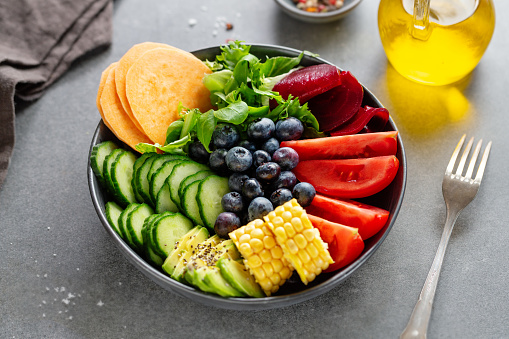The Benefits of Incorporating a Variety of Colors of Fruits and Vegetables in Our Diets

The Benefits of Incorporating a Variety of Colors of Fruits and Vegetables in Our Diets
Incorporating a variety of colorful fruits and vegetables into our diets is one of the best things to do for our overall health and well-being. These foods are packed with essential vitamins and nutrients, and their vibrant hues offer various unique health benefits. This article will explore why eating a rainbow of fruits and vegetables is important and its many benefits.
4 Benefits of Eating Colorful Fruits and Vegetables
Provides essential nutrients
First and foremost, eating various colorful fruits and vegetables is essential for getting all the nutrients our bodies need. Each color group offers a unique set of vitamins, minerals, and antioxidants that help keep our bodies functioning at their best. For example, red and pink fruits and vegetables like tomatoes, watermelon, and grapefruit are rich in lycopene, a powerful antioxidant that helps protect against heart disease and cancer.
Meanwhile, orange and yellow fruits and vegetables like carrots, sweet potatoes, and mangoes are high in beta-carotene, which is essential for healthy eyes and skin. And green fruits and vegetables like kale, spinach, and avocado are loaded with vitamins A, C, and K, as well as iron and calcium.
It's not just about getting enough of each nutrient - eating a variety of colors also helps ensure that we're getting the right balance of nutrients. For example, if we only eat green vegetables, we might miss important nutrients like beta-carotene and lycopene. By incorporating various colors into our diets, we can be sure we get various vitamins and minerals supporting overall health.
Prevent chronic diseases
Another benefit of eating various colorful fruits and vegetables is that they can help prevent chronic diseases. Research has shown that diets rich in fruits and vegetables can help lower the risk of heart disease, stroke, and certain types of cancer. The antioxidants in these foods help protect our cells from damage and inflammation, which can lead to these and other chronic diseases. And because different color groups offer different types of antioxidants, eating a range of colors is important to get the full spectrum of benefits.
Adds flavor to Diets
Colorful fruits and vegetables add flavor and variety to our diets. By experimenting with different colors and textures, we can create delicious and satisfying meals that keep us returning for more. For example, a salad made with greens, red peppers, carrots, and blueberries offers a range of flavors and textures that can be more satisfying than a simple bowl of lettuce. And incorporating fruits and vegetables into smoothies, stir-fries, and other dishes can add depth and complexity to our meals.
Eco-friendly
Incorporating a variety of colorful fruits and vegetables into our diets is good for the planet. Eating a plant-based diet is one of the best ways to reduce our carbon footprint and help combat climate change. By choosing fruits and vegetables that are in season and grown locally, we can also support sustainable agriculture and reduce our reliance on fossil fuels.
Conclusion
There are many benefits to incorporating a variety of colorful fruits and vegetables into our diets. From getting essential nutrients to preventing chronic diseases, these foods offer a range of health benefits that support overall well-being. And by experimenting with different colors and textures, we can create delicious and satisfying meals that keep us coming back for more. So next time you're at the grocery store or farmers' market, remember to eat a rainbow of fruits and vegetables - your body (and the planet) will thank you!
